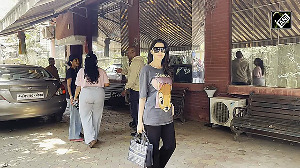It is not often recognised that indirect tax reforms in our country have made reasonable progress in the past few years. You may not agree with the pace of these reforms, but the indirect tax regime today is simpler and more stable than it used to be a decade ago.
Not only have the customs and excise duty rates seen a steep decline, the slabs too have been reduced making tax administration easier and the scope for disputes even more limited.
The most significant stride has been made in respect of the excise duty structure -- the ground has been made ready for the introduction of a single value-added tax regime.
A Cenvat rate (the finance ministry's nomenclature for VAT introduced by the Central government) of 16 per cent has been introduced for a majority of the items.
There are two more rates -- 24 per cent and 8 per cent. And both these rates will have to be aligned with the Cenvat rate of 16 per cent over the next two years.
Critics will point out that in reality there are several other rates of excise duty that continue to be applied on different items, subject to their end-use. But the trend is clear. And the alignment of excise rates on remaining items to the Cenvat rate of 16 per cent should be completed by 2006-07.
The coming two budgets may also bring the service tax rate, currently levied at 10 per cent on about 77 services, closer to the Cenvat rate of 16 per cent. There is strong resistance to the move from several service providers but in the last decade, the coverage has widened and the rate has doubled to 10 per cent.
The service tax and Cenvat will one day be unified to become a unified VAT at the Central level. Already, from last year, the finance ministry has started allowing a manufacturing company to adjust its Cenvat liability against the service tax it pays at the intermediate stage of production.
In other words, a manufacturing company today can take credit for the service tax it pays on advertising services obtained from its agency while paying the Cenvat on its final product.
Similarly, a services company is taking credit for the Cenvat it pays on its raw materials to pay the service tax on the final service it offers to a client. So, the industry already knows the road map and a gradual alignment of the service tax with the Cenvat rate will not come as a jolt.
A unified Central VAT regime, however, will only be half the job done. From April 1, 2005, the states are expected to replace their sales taxes with a state VAT rate of 12.5 per cent. Almost all the states are ready and going by Haryana's example (it collected more revenue even though it had a state VAT rate of ten per cent in force), they have nothing much to worry.
In case, they suffer any revenue loss, the Centre has already promised them adequate compensation in the first three years. Moreover, establishments with an annual turnover below Rs 500,000 will be exempted from the new regime and those with a turnover between Rs 500,000 and Rs 50 lakh (Rs 5 million) will have the choice of opting out of the VAT system and instead pay an alternative tax at the rate of 1 per cent of their annual turnover.
But replacing the state sales tax with a state VAT rate of 12.5 per cent will leave at least two other state level taxes in the system. There is a central sales tax rate of 4 per cent and a new service tax rate to be levied on 100 such services on which states alone can impose the tax. The central sales tax has to be gradually phased out, a task that is going to be very difficult.
Similarly, the states will have to levy the service tax rates on 100 services, which, too, will have to aligned with the state VAT rate over a period of time. This may take anywhere between three and five years.
The states will see a unified VAT regime only when the central sales tax is eliminated and the state VAT is aligned with the state service tax. Finally, the state VAT will be unified with the Central VAT. That will give India a truly unified VAT regime. And this might take another five years.
It is clear by now that the Union finance ministry has opted for a gradual integration of various taxes at the Central and state levels to achieve a unified VAT regime for the whole country.
This is in sharp contrast to the formula suggested by Vijay Kelkar, former advisor to the finance minister, which had recommended a swift transition to a unified goods and services tax of 14 per cent.
Finance ministry officials have obviously preferred a slow and steady march towards a unified VAT regime. You might quarrel with the slow pace of reform, but at least there would be no sudden shocks of a reversal.






 © 2025
© 2025